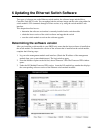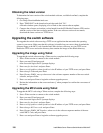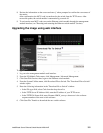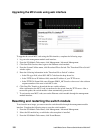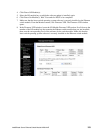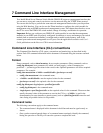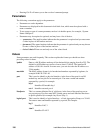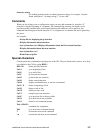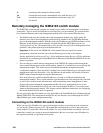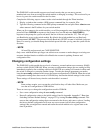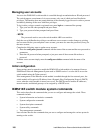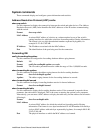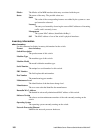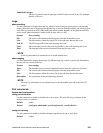156 Intel® Blade Server Ethernet Switch Module IXM5414E
• Entering Ctrl-Z will return you to the root level command prompt.
Parameters
The following conventions apply to the parameters:
• Parameters are order dependent.
• Parameters are displayed in this document in bold italic font, which must be replaced with a
name or number.
• To use spaces as part of a name parameter, enclose it in double quotes, for example, “System
Name with Space”.
• Parameters may be required or optional, and may have a list of choices.
— <parameter> The angle brackets indicate that the parameter is required and you must enter
a value in place of the brackets and text.
— [parameter] The square brackets indicate that the parameter is optional and you may choose
to enter a value in place of the brackets and text.
— choice1/choice2 Enter one and only one of the values listed.
Values
Some parameters are used frequently. This section explains the format you should use when
providing values for them.
ipaddr Enter a valid IP address made up of four decimal digits ranging from 0 to 255. The
default for all IP addresses consists of zeros (that is, 0.0.0.0). The interface IP
address of 0.0.0.0 is invalid. In some cases, you can also enter the IP address as a
32-bit number.
macAddr The MAC address format is six hexadecimal numbers separated by hyphens, for
example 00-06-29-32-81-40.
port This is used to identify a physical interface, in the form of bay.port for an I/O
module bay and ext.port for an external port. You enter a name and number
separated by a period, for example:
bay.1
identifies I/O module bay 1
ext.4 identifies external port 4
listofports This is a comma-delimited list of valid ports, in the form of bay.port,bay.port or
ext.port,ext.port. Port lists must NOT contain spaces and each interface must have
its prefix specified (for example: bay.10,ext.2,bay.1)
logical port This is used to identify a logical interface – a Link Aggregation Group or a VLAN.
You enter a name and number separated by a period, for example:
lag.3
identifies LAG 3
vlan.2
identifies VLAN 2




